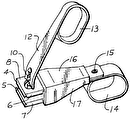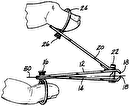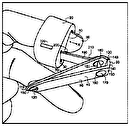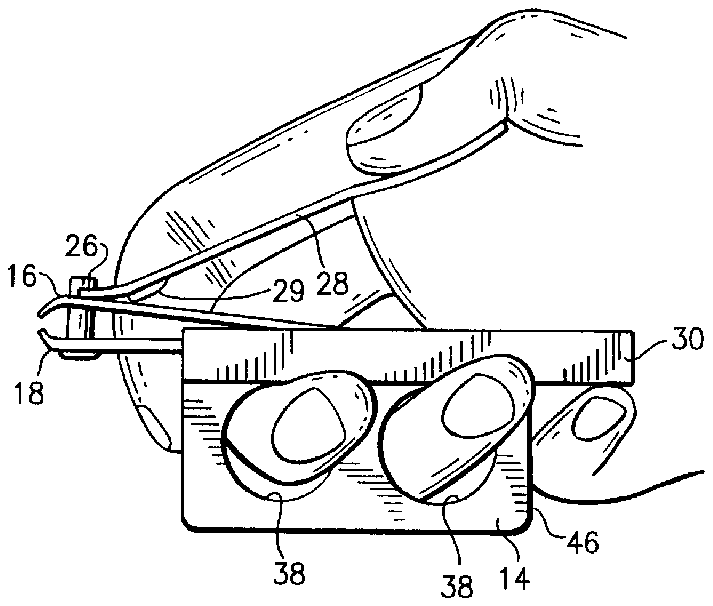
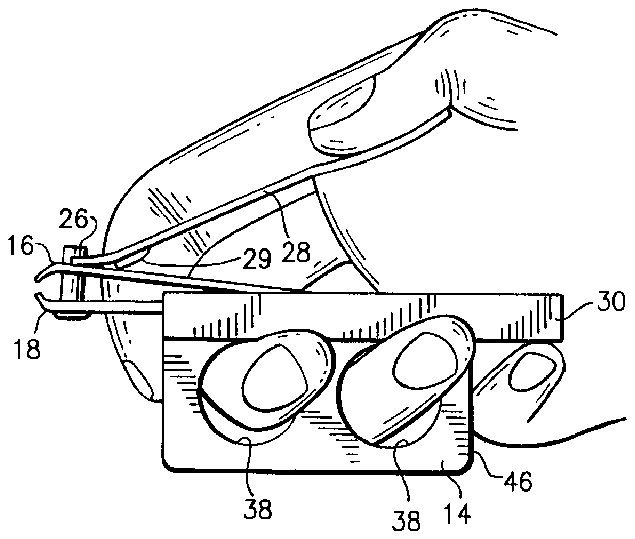
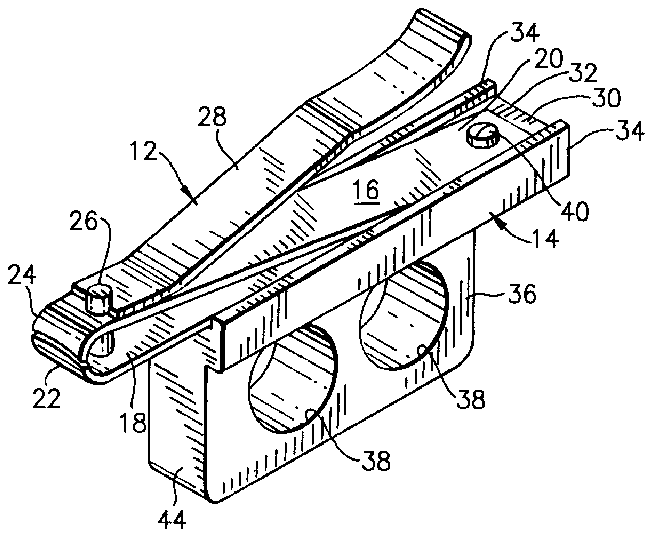
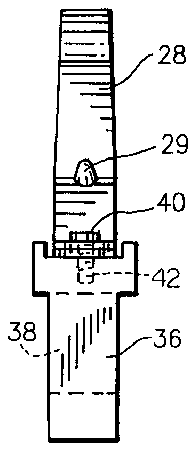
- 10generally designated
- 12clipper
- 14aid
- 16elements
- 18elements
- 20end
- 26post
- 28operating lever
- 29downward pressure bump
- 30channel
- 32web
- 34flanges
- 36fin
- 38openings
- 40bolt
- 42bore
- 44fin
- 46rear end
Abstract
The aid comprises a channel including a central web and flanges extending in a first direction, the channel is formed with a fin extending in a second direction opposite the first direction. The fin has at least one finger opening therein. The usual nail clipper is mounted in the channel with the operating lever extending away from the aid so that it is readily operable.
Description
FIELD OF THE INVENTION
This invention relates to finger and toenail clippers. More specifically, the invention relates to an aid for making such clippers more comfortable, easier and accurate to use.
BACKGROUND OF THE INVENTION
Nail clippers utilizing a pair of leaf spring elements secured together at one end and having cutting edges at the other end are well known. Usually a fulcrum post is rotatably mounted on one of the elements adjacent its cutting edge and extends through the other element for support of a fulcrum lever used to move the cutting edges toward each other to produce cutting.
Attempts have been made in the past to provide structure or accouterments for such clippers so that they will be easier to use. An example is the Tottenham U.S. Pat. No. 5,384,960 wherein rings are provided on the ends of the lever and the spring elements, the rings being adapted to receive the fingers or thumb of the user to improve the grip.
U.S. Pat. No. 3,744,131 to Manes discloses a clipper having a finger hook and thumb piece on the respective lever and cutting element.
Rommerdale U.S. Pat. No. 5,052,416 discloses molded plastic attachments for the lever and a clipping element to make them easier to use.
Sartore U.S. Pat. No. 3,997,966 proposes scissor-like thumb and finger handles to make the apparatus easier to use and direct.
While these improvements provide some help, no one of them permits the involvement of the entire hand to hold and operate the clipper. With such involvement, as I now provide, the clipper is much easier and more comfortable to direct and operate.
SUMMARY OF THE INVENTION
The invention is, of course, defined in the appended claims. In summary, however, I provide an attachment for a toe and fingernail clipper well known in the art. The attachment is an aid which may be defined as a channel including a central web and flanges extending in a first direction, the channel is formed with a fin extending in a second direction opposite the first direction. The fin has at least one finger opening therein. The clipper is mounted in the channel with the operating lever extending away from the aid so that it is readily operable.
BRIEF DESCRIPTION OF THE DRAWINGS
Further objects and features of the invention will be clear to those skilled in the art from a review of the following specification and drawings, all of which present a non-limiting form of the invention. In the drawings:
FIG. 1 is a side elevation of a toenail clipper installed in a gripping aid embodying the invention. The assembly is shown held in a hand as it would be in use.
FIG. 2 is a perspective view; and
FIG. 3 is a rear elevational view.
DESCRIPTION OF THE PREFERRED EMBODIMENT
A toenail clipper and the gripping aid is shown as an assembly in FIG. 2 and generally designated 10. It comprises the clipper 12 and the aid 14.
As is well known in the art, the clipper is defined by a pair of leaf spring elements 16 and 18. They are secured together at one end 20 as by a rivet or welding, and the second end of each is formed with a cutting edge 22, 24. A fulcrum post 26 has on its lower end a head (not shown) and extends through openings in the two elements 16, 18 and is formed with a notch (not shown) above element 16. The notch receives an end of an operating lever 28 having a downward pressure bump 29.
The gripping aid 14 is a single block of metal or plastic which comprises a channel 30 including a web 32 and two side flanges 34. A fin 36 extends in a direction opposite the direction of the flanges 34 from the underside of the channel. It is formed preferably with a pair of finger openings 38.
As shown, a single bolt 40 passes through a hole in the end 20 of the clipper and is screwed into a tapped bore 42 in the channel 30. This secures the clipper in the aid 14 and, when tightened, effectively holds the clipper. The flanges 34 of the channel 30 keep the aid from rotating relative to the clipper.
Alternatively, the clipper can be secured in the channel 30 by an epoxy cement.
It should further be understood that the aid as described may also be used with a fingernail clipper (not shown) which is shorter than the toenail clipper 12. In securing the fingernail clipper, the bolt 40 may be secured to the aid 14 about midway along the channel as shown in FIG. 2. In other words, the bolt and the bore 42 may be, for instance, somewhat inbetween the openings 38. This is because, of course, the elements 16 and 18 of the fingernail clipper are shorter than those shown, and it is desirable to have the cutting edges 22, 24 extend beyond the front end of the fin 44.
Thus, as shown in FIG. 1, the index finger can conveniently rest upwardly against the underside of the leaf spring element 18 irrespective of whether a toenail or fingernail clipper is installed in the aid. The channel 30 preferably extends beyond the rear end 46 of the fin 36 so that it may be engaged by the little finger.
Many of the benefits of the invention can be achieved by the use of an aid 14 wherein the channel 30 is replaced by a single web 32 without flanges 34, the upper surface of the web 32 serving to engage the underside of the clipper. In such a case, an epoxy cement may secure the aid 14 to the clipper 12.
The convenient benefit of the clipper being collapsible can still be enjoyed using the aid, as the operating lever 28 can be swiveled about the axis of the post 26 and then flopped over so that the lever 28 engages the leaf spring element 16.
Variations in the invention are possible. Thus, while the invention has been shown in only one embodiment, it is not so limited but is of a scope defined by the following claim language which may be broadened by an extension of the right to exclude others from making, using or selling the invention as is appropriate under the doctrine of equivalents.
